You may think you know about wasabi and how it plays Sushi’s supporting role, but how much do you really know? Today, let’s go back to basics!
History of Wasabi
Wasabi is indigenous to Japan. It is not only native to Japan, it is also only traditionally grown and eaten in Japan. It is essential to the food culture of Japan and represents the tastes of Japanese people.
Now sushi and wasabi are an inseparable duo, but the first time wasabi was actually used with sushi was at the end of the Edo period. Of course, wasabi has its own taste and flavor, but the effects of offsetting the odor of fish and suppressing the growth of bacteria were probably learned through experience. It quickly became a staple among common people and its popularity spread throughout the country.
Let’s examine the appeal of wasabi from a variety of angles
The spiciness and aroma of wasabi come from allyl isothiocyanate and small amounts of butyl isothiocyanate, which are produced by the hydrolysis of the mustard oil glycoside sinigrin when the wasabi rhizome is grated. This occurs when the enzyme myrosinase, exposed to oxygen, hydrolyzes the mustard oil glycoside sinigrin.
As the mustard oil glycoside is hydrolyzed to produce the pungent component, the glucose bound to the glycoside is released, resulting in a sweet, smooth spiciness.
The aroma of wasabi is known as a green note, and is a volatile substance called 6-methylthiohexyl isothiocyanate.
The mustard oil glycoside is found between the epidermis and the cortex. Within the cells, the glucose portion of the mustard oil glycoside exists as a bond with potassium sulfate.
Peeling the skin too thickly will prevent the wasabi from being pungent. The tip of the wasabi rhizome is spicier because it contains a higher proportion of epidermis and cortex. The reason the spiciness weakens when grated wasabi is dissolved in soy sauce or vinegar is because the salt and pH inactivate the hydrolytic enzymes.
Also, leaving it for about five minutes after grating allows the hydrolytic enzymes to act for a longer period of time, resulting in the production of more pungent compounds, resulting in a spicier wasabi.
Actually, daikon radish is from the same Brassicaceae family of plants. The spicy feeling you get when eating grated daikon radish is from the exact same components. The Karami daikon (hot daikon) is an especially pungent variety, and it has been used as a seasoning in the same way as wasabi for soba noodles. Generally, when people around the world think of spiciness, they think of the cayenne pepper, but Japanese people tend to like the mustard oil spice.
Wasabi is pungent, but it lasts for a very short time and after it passes through the nose, it leaves you with a cool sensation, and there is no feeling of discomfort. The stimulation increases your appetite. If you drink a hot drink like tea, it resets your palette, making you eager for the next delicious bite. Its appearance makes an impact, but it’s actually subtle, it isn’t flashy, but it is unique, practical, effective, with a strong taste. It is a really exquisite balance.
Types of Wasabi
Wasabi is divided into the two major categories of Hon-wasabi and Seiyo-wasabi (western wasabi, or horseradish). Honwasabi is the wasabi grown in Japan that we generally think of when we hear the word wasabi. The most famous types of Honwasabi include Mazuma (真妻), Daruma (だるま), Masamidori (正緑), Shimane-sangou (島根3号), but since these are used to breed new types on a daily basis, there is an infinite number of types of wasabi.
Hon-wasabi is further divided into the two major categories of Sawa-wasabi and Hatake-wasabi. The name of these categories is derived from how each type is cultivated, but there is no difference in the botany of the two. “Sawa-wasabi” is also known as “Mizu-wasabi” (water wasabi) and it is cultivated in clean, flowing water full of nutrients at a constant temperature. This is mainly cultivated as a seasoning for dishes like sushi and soba.
“Hatake-wasabi” is also called “Riku-wasabi” or land wasabi, and is cultivated in the soil like other vegetables. The rootstock grows in the ground, so it doesn’t get too big and it is mainly grown here for use of the leaves and stem. The leaves and stems are shipped as raw materials for processed foods.
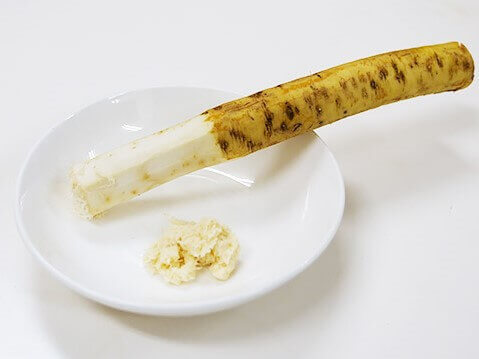 On the other hand, “Seiyo-wasabi” refers to the horseradish cultivated in Europe, which is called “wasabi daikon” or “yama-wasabi” (mountain wasabi) in Japan. It’s the same perennial herb of the Brassicaceae family, but hon-wasabi is of the Eutrema genus and Seiyo-wasabi is part of the Armoracia genus. The color, shape and flavor are different, so they are similar but different.
On the other hand, “Seiyo-wasabi” refers to the horseradish cultivated in Europe, which is called “wasabi daikon” or “yama-wasabi” (mountain wasabi) in Japan. It’s the same perennial herb of the Brassicaceae family, but hon-wasabi is of the Eutrema genus and Seiyo-wasabi is part of the Armoracia genus. The color, shape and flavor are different, so they are similar but different.
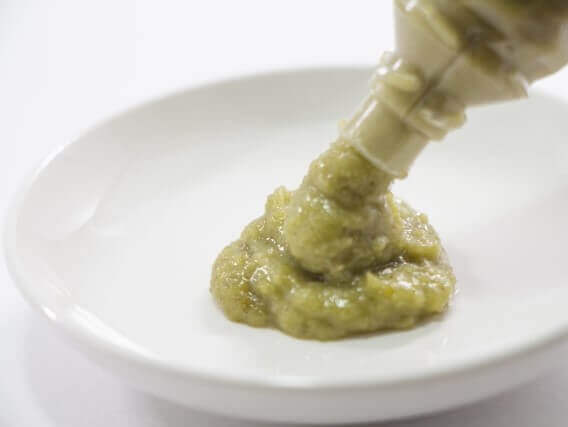 Many powder and mixed wasabi products (Fake wasabi) use this horseradish as the raw ingredient, but there are also other ingredients besides the stock root of hon-wasabi used to create the aroma and color of wasabi. When the package states “Made from hon-wasabi,” this means that 50% or more of the contents are wasabi and when it says, “includes wasabi,” that means that less than 50% of the contents are wasabi.
Many powder and mixed wasabi products (Fake wasabi) use this horseradish as the raw ingredient, but there are also other ingredients besides the stock root of hon-wasabi used to create the aroma and color of wasabi. When the package states “Made from hon-wasabi,” this means that 50% or more of the contents are wasabi and when it says, “includes wasabi,” that means that less than 50% of the contents are wasabi.
Mazuma (真妻)
This breed comes from the former Mazuma Village. Due to the excellent quality, cultivation of this wasabi spread, mostly to Shizuoka. The stem is purple. Hypertrophy of the root stock is nice and firm, so it lasts for a long time and has high marketability. However, it is prone to disease and since it grows slowly, it’s difficult to make a profit with this wasabi so cultivation of it has declined drastically in recent years.
Daruma (だるま)
This is a species selected from the discovery of a superior strain that appeared as a mutant strain from the Hanbara species, brought from Kanagawa prefecture. However, a rapid retrogressive phenomenon started occurring from 1965 and nowadays there isn’t much left of the original strain so Shizuoka has been putting most of its efforts into Mazuma instead. The leaves of Daruma are dark in color and heart-shaped while the stems are green. The rootstocks are fleshy and are excellent in quality.
Masamidori (正緑)
This species is a descendant of Mazuma, but larger in size and with improved resistance to disease. Both the rootstocks and stems promise high yields. As the name suggests, this species is a beautiful green color and it is characterized by its large roots. It is widespread along the Abe River in Shizuoka and in Hotaka, Nagano prefecture. It is becoming more appreciated in recent years, especially in Nagano as a species with high yields.
Shimane-sangou (島根3号)
This species was born at the Shimane Prefectural Agricultural Experimental Station through natural crossbreeding between local varieties from Shimane prefecture and disease-resistant strains brought in from all over Japan. It tends to grow well in places with a lot of sunshine or warmer water, and also tends to be resistant to diseases specific to wasabi. This is an excellent variety with both spiciness and sweetness. It once dominated Japan and was often used at luxurious restaurants.
New species of wasabi
As previously mentioned, wasabi is a very delicate plant in which the retrogressive phenomenon will occur at about the 10-year mark, and it will degenerate from then on. Various species must be crossbred, creating new species.
Wasabi cultivation starts with a breeding method called root division, then proceeds to seedlings and finally mericlone, which uses biotechnology. Now, good species can be made using seedlings, then stabilized by raising equivalent plants through mericlone and distributing these.
New species that are already being cultivated using mericlone include Mazuma No. 1, Amagi-nishiki, Akaoni and Maruichi, among others. Some of their characteristics are introduced below.
Hyuga (飛河)
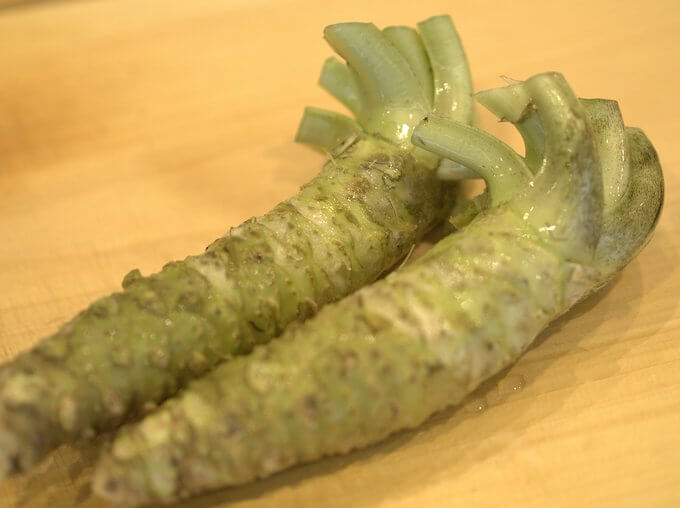 This is an early harvest green-stem species with nice, thick root stocks and a nicely shaped rhizome (potato). This species grows vigorously and is characterized by its bright green color.
This is an early harvest green-stem species with nice, thick root stocks and a nicely shaped rhizome (potato). This species grows vigorously and is characterized by its bright green color.
Ishidaru (イシダル)
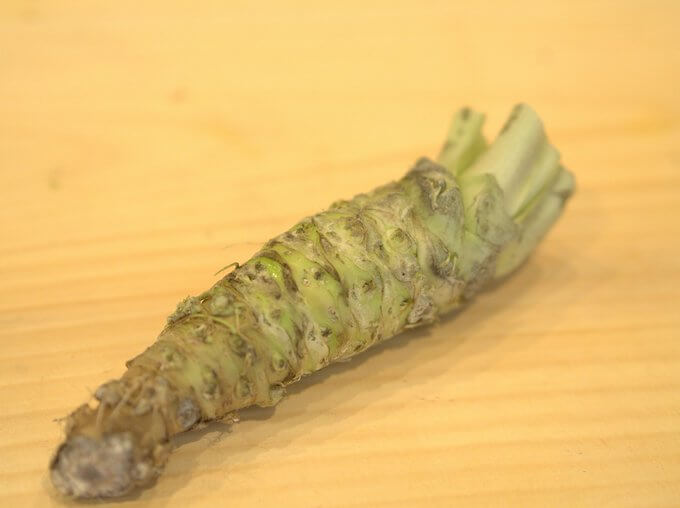 The leaves, stems and roots are a bright green color and this is also an early-harvest species. The color, stickiness and creamy flavor when grated are very highly regarded. It is a strong variety that grows even in cold regions such as Yutogi.
The leaves, stems and roots are a bright green color and this is also an early-harvest species. The color, stickiness and creamy flavor when grated are very highly regarded. It is a strong variety that grows even in cold regions such as Yutogi.
Onimidori (鬼緑)
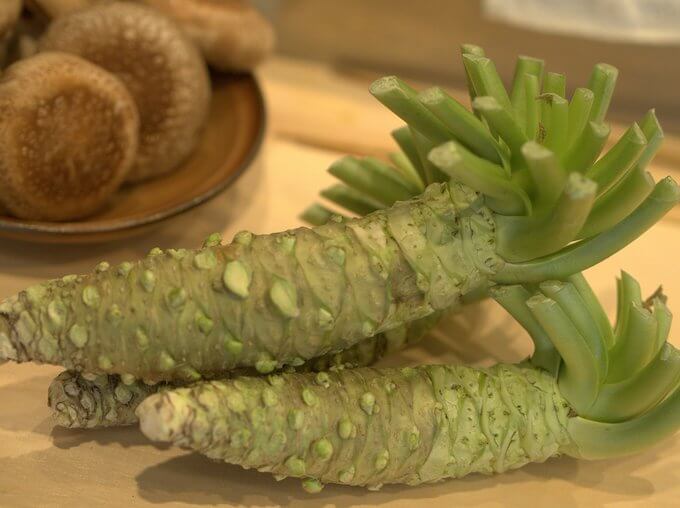 This is a very early-harvest, green-stem variety with a nice thickness in the rootsock and a deep green color and happens to be one of the few root division types. This wasabi grows downstream where the water temperature is unstable, and its rootstock is a beautiful green color.
This is a very early-harvest, green-stem variety with a nice thickness in the rootsock and a deep green color and happens to be one of the few root division types. This wasabi grows downstream where the water temperature is unstable, and its rootstock is a beautiful green color.
To summarize, there are naturally no sushi chefs who are familiar with the new varieties of wasabi. They are still in the seeking stage to find which species suits their sushi the best. For example, Mazuma No. 1 ranks slightly lower in quality compared to Mazuma made from root division. This is just about all the information that is available at this time.
Wasabi health benefits
Wasabi has been known for its antibacterial action and odor eliminating effects. Researchers focused on those components discovered that wasabi contains 6-Methylsulfinylhexyl isothiocyanate (6-MSITC), which is a health component contained in trace amounts of the rootstock of wasabi. The many effects discovered in 6-MSITC include detoxification, antioxidative effects, improving blood flow, carcinoma cell metastasis inhibition effects, diabetes complication prevention effects, hay fever relief effects, inflammation suppression effects, knee joint pain suppression effects and beauty effects, among others. Of those, the important effects for sushi are detoxification and bacteriocidal effects.
About 1300 years ago, wasabi was used as a medicinal herb. It was valued as a useful medicinal herb, and besides the antibacterial action used to prevent food poisoning, it has also been used for detoxification effects. In ancient texts, there is even an expression, “It counteracts fish poison.”
The antimicrobial activity of the spicy component of wasabi works to suppress the proliferation of causative microorganisms of food poisoning such as pathogen E‐Coli O‐157, salmonella, vibrio parahaemolyticus, Staphylococcus aureus, etc. This is because of the antibacterial action in various mustard oils that are also contained in wasabi and mustard. Of these components, Allyl isothiocyanate, which is especially abundant, has strong antibacterial effects when activated and is effective for suppressing the proliferation of vibrio parahaemolyticus, salmonella, O-157, etc. Furthermore, it is effective in suppressing mold and yeast growth and insecticidal action against parasites has also been confirmed. However, Allyl isothiocyanate is not effective against all microorganisms, so it is important to accept the strength to be bacteriostasis rather than disinfection, and to not be overconfident in the effects.
Why does “Mazuma” wasabi go best with sushi?
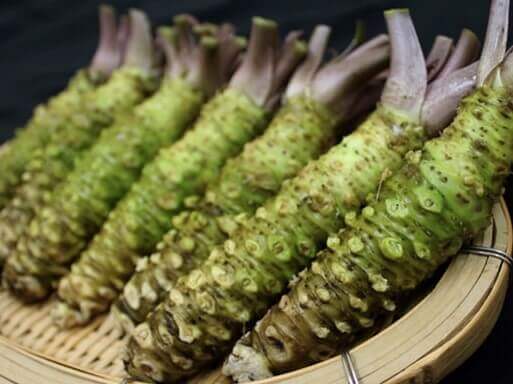 While there are countless types of wasabi, Mazuma has been ranked as the greatest of all. It has the perfect balance of sweetness, stickiness and wasabi’s pungent aroma. The stem of Mazuma wasabi is a reddish-purple color, so you can recognize it immediately.
While there are countless types of wasabi, Mazuma has been ranked as the greatest of all. It has the perfect balance of sweetness, stickiness and wasabi’s pungent aroma. The stem of Mazuma wasabi is a reddish-purple color, so you can recognize it immediately.
Mazuma is grown from root division, unlike the seedlings that use young plants grown from seeds. Cultivation is also difficult and requires 2-3 years, while other wasabi plants only take 1.5-2 years. Therefore it yields a high scarcity value and you won’t find it at the supermarket, as it is only supplied to high-end sushi restaurants.
This Mazuma is mainly produced in Izu, and Shizuoka is well known for its Mazuma. However, the birthplace of Mazuma wasabi was actually the former Mazuma region (currently Inamicho-kawamata) of Wakayama prefecture. There are about 300 farmers in the city of Izu, but only about 10% of these farmers cultivate Mazuma wasabi exclusively.
Sushi restaurants don’t like to use wasabi that is soft with no-stick that makes the rice soggy. The watery Misho wasabi used for mass production is better for western foods than for sushi. When you put Mazuma wasabi in your mouth, the aroma fills the air before the spice takes effect. Rather than the sharp flavor of the Misho, Mazuma has a deep, gentle spice, ideal for sushi restaurants.
Does the amount of wasabi change based on the sushi?
Wasabi is a very delicate seasoning. The way it’s used differs depending on the sushi topping. Generally, wasabi isn’t as effective for toppings with high-fat content, and very effective on toppings with lower fat content. For example, the reason wasabi works well with squid is the low-fat content. On the other hand, wasabi isn’t as effective on the red meat of tuna. That’s why it contains more. Furthermore, when it comes to toro, often more wasabi is used than the akami (red meat) of the tuna.
Is it shameful to ask for nigiri-sushi without wasabi?
Occasionally someone will say, “Excuse me, please make mine without wasabi.” The sushi chef will always respond with, “No problem (“Aiyo-” in Japanese),” but some chefs are thinking in their head, “C’mon, you’re not a child.”
That’s because there are many sushi chefs who believe that nigiri-sushi without wasabi is not nigiri-sushi.
The pungent stimulation from fresh wasabi whets the appetite. However, unlike spicy mustard, the taste doesn’t linger, which is why it goes so well with simple sushi. Even the amount of shari is calculated based on the topping and wasabi. In addition, wasabi has anti-bacterial effects and also preservative efficacy, preventing food poisoning. It also has the effects of expelling parasites such as Anisakis. To sushi chefs, wasabi and nigiri-sushi are a single unit and the true taste of the sushi can’t be brought out without wasabi. Therefore, their true feeling is that they even want children to eat the sushi they make with the wasabi.
Meanwhile, from the customer’s perspective, there are many people that order no wasabi because they can’t handle the unpleasant spiciness that goes through your sinuses. This is because they believe that the unique spicy flavor of wasabi powder is the hon-wasabi flavor. When these people learn the true, gentle flavor of hon-wasabi, they sometimes end up actually liking wasabi.
Incidentally, many people also probably believe that wasabi powder is dehydrated hon-wasabi*, but it’s actually completely different. Wasabi powder is made from dehydrated horseradish with synthetic mustard powder, starch to dilute the spiciness and green coloring among other ingredients. The color ends up being an unnatural peppermint green. The price is much cheaper than hon-wasabi (hon-wasabi is the US $60 to $120 per kilogram while horseradish is $10 per kg), so most kaiten-zushi (conveyor belt sushi) restaurants use wasabi powder. However, according to sushi chefs, nigiri-sushi made with wasabi powder is not truly nigiri-zushi in the same way as nigiri-sushi made with real wasabi.
*The scientific name of hon-wasabi is wasabi japonica and the wasabi used in sushi is made by a grating that wasabi root.
How to select Wasabi
Find a plant that has the same thickness from root to tip, with a bright green color. Wasabi grows while dropping stem leaves, which leave a bumpy surface on the plant. It’s like the rings you find in trees. These bumps are proof of deliberate growth and mean that the quality is good and the spiciness and flavor are good as well. Also, wasabi is cultivated so that it can be harvested all year long, but it is more pungent in the colder months so it’s considered to be in-season from November to February.
How to grate Wasabi
The cells on the tip are older and those closer to the stem are younger. The younger it is, the more watery and fresher the color. The potency is in the tip. In general, it’s considered better to grate from the base, but if you’re going to use one wasabi plant divided over a number of times, it’s better to start at the tip so that you don’t lose any of the flavors. Mustard oil has volatility so it’s at peak spiciness about 5 minutes after grating, then the flavor starts to drop gradually after about 30 minutes have passed. The smaller the spikes on the grater, the more cells it can break open, making more mustard oil. This is why the rough shape of the sharkskin is perfect for grating wasabi.
A thorough comparison of Wasabi graters
There are various types of wasabi graters. The grater you’ll usually see at a sushi restaurant is called a sharkskin. You may wonder if sharkskin is really that great, or what kind of grater you should buy for your home. Let’s compare the features of the three major types of graters: sharkskin, stainless steel, and ceramic.
 Sharkskin
Sharkskin
This is the typical tool for grating wasabi. Long ago during the Edo period, carpenters used shark skin as a file and that’s where the idea came from. Even though it’s written as “shark” skin, most of these graters are made from drying the skin of one type of “ray” fish. The rough form, which is made of the same type of enamel as human teeth is used to grate the wasabi, It can grate very finely and creates a creamy finish. It is the best for bringing out the sweetness, spiciness, stickiness and other potencies of the wasabi, but you need to be careful when procuring one. It needs to be washed with cold water, and set out to dry in the shade. No detergents or dryers can be used on it. It also shouldn’t be soaked in water for long periods of time.
 Stainless steel
Stainless steel
This is the fastest tool for grating wasabi and it’s the easiest to find. It doesn’t have the creamy texture of wasabi grated with sharkskin and it has a rougher finish, but some people actually prefer the lumps left in it. Still, the aroma and stickiness can’t compare to sharkskin.
 Ceramic
Ceramic
Just like stainless steel, this tool makes it quick and easy to grate Wasabi. Also, most of the ceramic utensils can be used for serving on the dinner table, so it’s gaining popularity. It brings out a clear spiciness, but the aroma is lacking, like with the stainless steel version.
Each has its own advantages and disadvantages, but if you want to create the best taste, the sharkskin is the only option. Leading to the conclusion that our ancestors’ wisdom was amazing. No matter which utensil you use, the secret to grating wasabi is to take it slow and grate in a circular motion without pressing down too hard. This will give you aromatic, tangy wasabi to enjoy.
How to Store Wasabi
Wrap it in a wet newspaper, then wrap that in plastic wrap and store it in the refrigerator. The wasabi can also be placed in a cup of water and put in the refrigerator. This method can be used for about one month. If you want to store it even longer, freeze it first, then grate it without thawing, and freeze again.
Famous places where Wasabi is farmed
Innan(印南)
 Wasabi fields you can visit
Wasabi fields you can visit
Daio Wasabi Farm
Address:3640 Hotaka Azumino-city Nagano prefecture, Japan
Phone:+81-263-82-2181
HP:https://www.daiowasabi.co.jp/
Wasabi-en Kadoya
Address:371-1 Nashimoto, Kawazu-cho, Kamo-gun, Shizuoka Prefecture, Japan
Phone:+81-558-35-7290
Related Content:
Does the taste of wasabi differ depending on the grater?!
Why do some sushi toppings have ginger instead of wasabi?
Best supporting role for wasabi that magnifies the umami in sushi many times over.
Why is wasabi always served with sushi and sashimi?
Share this article
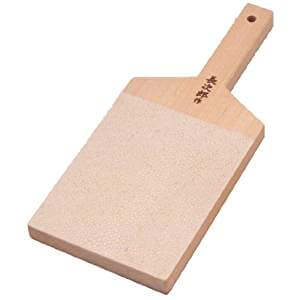 Sharkskin
Sharkskin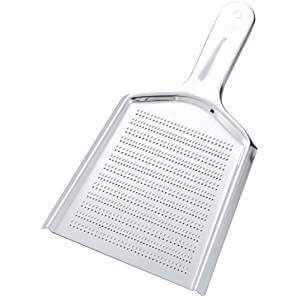 Stainless steel
Stainless steel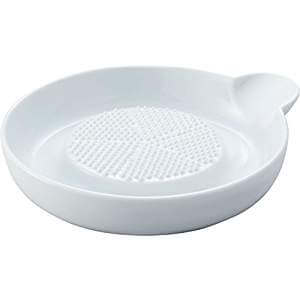 Ceramic
Ceramic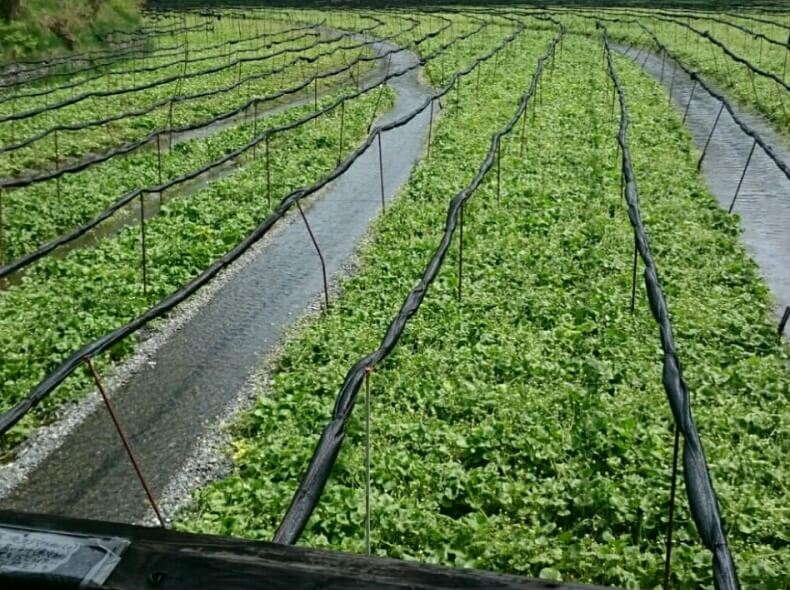 Wasabi fields you can visit
Wasabi fields you can visit